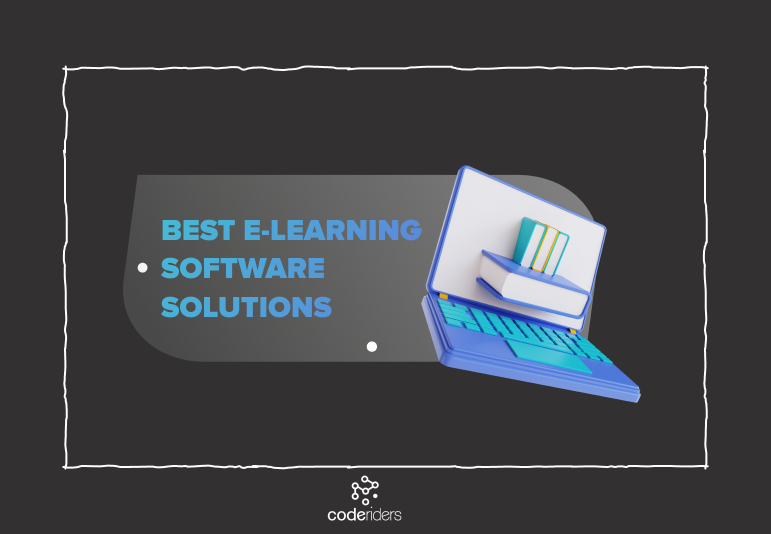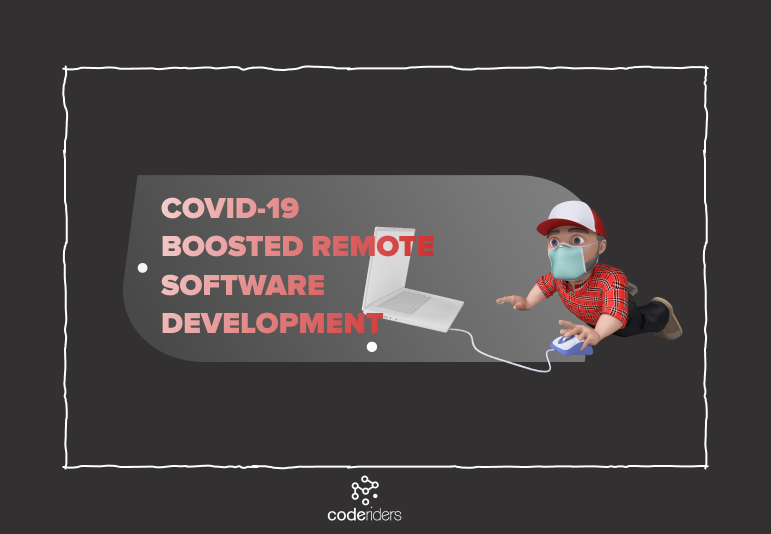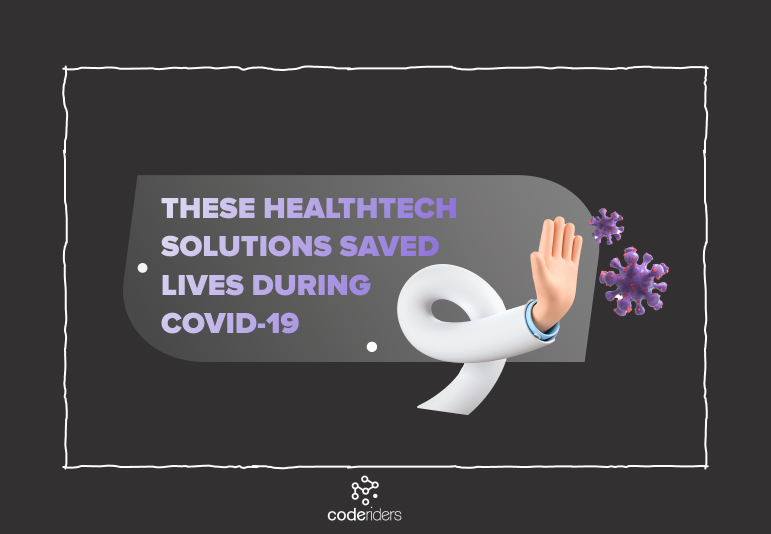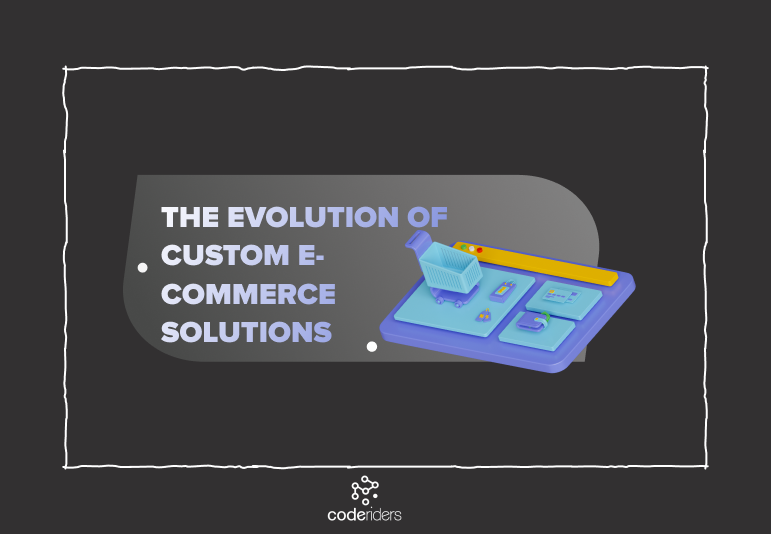EdTech solutions ensure that no crisis, emergency situations can ruin the successful learning process. As an example, the importance of high-quality Education Management maintained stability from the very beginning of the Coronavirus pandemic to these days. Countries have quickly adapted the best EdTech solutions to replace traditional education.
Today distance education and online learning during COVID-19 are still evolving quickly. Technological innovations, student mobility, government regulations are emerging.
Custom Software development companies, EdTech companies all around the world have already started developing and utilizing technology for large-scale, national as well as private institutions in support of remote learning. The already existing e-learning platforms, online schools, or classrooms are implementing complex tech solutions for remote education.
The importance and demand for Education Software Solutions now is assessed more than ever.
CodeRiders has also experienced the above changes in EdTech industry, thus we continue our series of articles about the impact of COVID-19 on some industry sectors. Our previous article was about Telemedicine. This time we’ll speak about EdTech industry’s functional updates during COVID-19 pandemic.
Subscribe to Newsletters
Before we dive in, let’s highlight some ways that Education Software Solutions make our lives stress-free and more organized. EdTech solves the following issues that are common in traditional learning.
- Scattered resources – Learner, Educator, and Learning Material
- Limited mobility
- Non-organized, sometimes vague collaboration between teachers, mentors, students, and parents
- Waste of time on Research and Development
- Absence of integrated platforms for specific groups
- Absence of multimedia content (pictures, graphics, sound, videos, online-based content)
If you’re a state or private education institution or an e-learning platform looking for more advanced software solutions during Coronavirus pandemic, this article is for you.
In this article you’ll learn about:
- EdTech Solutions (Best practices)
- ICT (Information and Communication Technologies), online learning during COVID-19 pandemic in various countries in the world
- Post COVID-19 EdTech Industry
Paperless Education: Best Practices
One of the common and more ''corporate software'' is Learning Management System, which may sometimes be referred to as a collective of specific education software.
1. LMS (Learning Management System)
LMS is a frequently used abbreviation and stands for Learning Management System, a software that is generally implemented to deploy and track online training initiatives.
However, LMS software is used for the specific company’s objectives, online learning strategies, and desired outcomes. Thus it’s highly customized. Assets are uploaded to the LMS, which make the education process possible from any corner of the world. It’s natural, that LMS quickly became one of the most crucial factors in effective organization of online learning during COVID-19.
Overall, LMS is a vast repository where you can keep and track information. Anyone logged in the system can have access to various online learning courses. LMS users are either online learners who use the software to fulfill online training courses or a specific team or a group of people who rely on LMS platform to disburse information and update online learning content.
LMS solutions are beneficial for various establishments starting from educational institutions to different consumer groups, such as companies specializing in e-commerce, CRM, online training courses, SMBs (Small and Medium Businesses), etc.
These consumer groups get their big data organized and safely stored, an opportunity to analyze and track students’ learning progress and performance, improve resource allocation, personalize online training experience, and more.
Various functions may be included according to the specific consumer’s requirements. Most of the countries’ governments organized their online learning during COVID-19 by integrating the following functions:
- Training sessions
- Online meetings and virtual classrooms
- Issuing reminders for recording sessions, audit-proofing, improving content availability, etc.
- Intuitive user interface and LMS navigation platform
- E-learning assessment tools
- Compliance and certification support
- Gamification features
- SCORM based LMS (makes the format of e-learning content shareable across the board)

Learning Management Systems also have several deployment options. Such as:
- Cloud-based (SaaS): These LMS platforms are hosted on the cloud, which means that the LMS vendor maintains the system and carries out any upgrades or updates. There is no need to install any software. Users log in to the LMS with a username and password.
- Self-hosted: The self-hosted LMS requires software downloads, which may be either a direct download from the site or a request for physical software discs. Nowadays, the first option is more popular. One of the essential advantages of such an option is advanced customization and creative control. A disadvantage may be paid updates or IT know-how requirements.
- Desktop Application: The LMS application is installed on your desktop and may be accessible on multiple devices, which makes team collaborations easier.
- Mobile application: The LMS application is installed on your mobile thus it’s accessible from anywhere as soon as you have your mobile with you. Online training content can be uploaded for learners to track online learning initiatives.
We, at CodeRiders also enjoy building Education Software Solutions. We’ve successfully had experiences collaborating with Educational institutions and businesses to build the tech systems enumerated in this article.
Subscribe to Newsletters
Our recent educational project was for a Hong Kong based English School. We built a web platform and a mobile application to connect teachers with parents/students, as well as to track and mobilize the school’s education system. The system is still under development but its beta version is available both on Play Store and App Store.
The project will soon be added to our portfolio section, so you’ll be able to check for more details.
2. Virtual Classrooms
Virtual classrooms have also become popular and essential alternatives for organizing online learning during COVID-19. These are online learning environments that allow live interactions between mentors, teachers, and students. Virtual classrooms and virtual lessons usually happen via videoconferencing. In this kind of virtual interaction teacher is the moderator of the online learning process and individual or group activities. Both participants have tools to implement or represent learning content or online activities in various formats.
The tools used during virtual classes include:
- Videoconferencing
- Instant messaging
- Breakout rooms
- Online whiteboard for live interaction and collaboration
- Tools for participation control

3. Online Examination Systems (E-examinations)
Perhaps one of the biggest challenges of the Education Industry was conducting examinations during Coronavirus lockdown. However, this sector became the most suffered one. State Education Ministries in various countries had to pare down the number of obligatory examinations to enter higher education institutions or enroll at high schools.
However, the examination system hasn’t met a total collapse during Coronavirus pandemic due to E-examinations.
get to know our team and software solutions
E-examinations or online examination systems are conducted as open-book examinations. The system provides concrete exam duration. After the time is expired, the answer paper is disabled automatically and answers are sent to the organizer. Afterwards answers are reviewed and evaluated by the examiner and the results are imported onto the system. The results are usually being sent to the students’ emails or are being published on the website. The post-exam notification process can be done either manually or automatically. This software implementation aims to cut out too much time spent on manual work and minimize the human factor.
E-examination software also has various features, minor functions, and tools and the overall structure of the system depends on the specific company’s or government sector’s requirements.
The minimum automated e-examination system is scalable, has a well-maintained database, allows teachers and students to view the exams and marks, and have an admin, who automates the user and exam system.
4. Authoring Systems
Authoring systems are another commonly used online learning methods during COVID-19. These are mostly built for teachers and mentors. Authoring systems help teachers create electronic flashcards or index cards, which are very productive and effective ways to mentor students on specific content. Authoring system software is also used to create multimedia content, such as lessons, tutorials, or reviews. There can be also web-based alternatives, which help teachers create multimedia web content that is used on a website.
5. Graphic software and desktop publishing software
COVID-19 lockdown evoked financial investments and total re-organizations of education management systems in various countries. However, it’s out of denial that the input of education software solutions made students’ learning process more fun and entertaining. The biggest examples are graphic software solutions. This software helps students create and edit pictures on the internet or in the program. Students mostly use it to create online presentations.
Desktop publishing software is another example of an engaging learning process. This software is used for creating designing handouts, flyers, etc. It’s a great solution to design a creative invitation for specific events.
6. Drill & Practice Software and Tutorial Software
Drill & Practice software is often used by teachers to prepare their students for exams or tests. This software has been used by a vast majority of teachers during COVID-19 lockdown. Tutorial Software is used both by teachers to prepare and present new lessons and by students to practise new skills on their own. It's also a very effective tool to evaluate progress.

7. Educational Games Software and Reference Software
One of the problems of organizing online learning during COVID-19 for the younger generation is the ability to maintain discipline remotely. Educational games have become frequently used software solutions to grab the students' attention. Educational games software motivates and encourages young adults to develop new skills through entertaining activities. While Reference Software is used for older generation students for research projects. This software gives access to atlases, encyclopedias, thesauruses, and various dictionaries.
Countries That Quickly Implemented Education Software Solutions During COVID-19 Lockdown
As mentioned earlier most of the countries in the world had a rapid response to the remote education system following the Coronavirus lockdown. The following countries implemented best practices for convenient remote education.
CodeRiders analyzed the updated information by The World Bank, an organization that constantly supports countries worldwide to obtain and use best practices of omnibus education.
Argentina
After the COVID-19 lockdown, the Argentinean Ministry of Education quickly developed educ.ar education platform, that connects teachers, administrators, students, and families. It also provides curated resources. The Ministry of Education and The Secretariat of Media and Public Communication developed a program called “Seguimos Educando”, which has started broadcasting educational content since April 1, 2020.
Chile
In Chile, students use the Aptus platform that hosts digital learning materials. The platform is financed by the Chilean Ministry of Education, which made the learning content available also to other countries in the region after COVID-19 lockdown.
Czech Republic
An online learning platform called “Distance Education” was launched by The Ministry of Education, Youth and Sport, on March 12, 2020. The platform aims to help students and teachers to continue classes via online learning during COVID-19 lockdown. The website has links to online educational tools, updated educational content on each class.
Italy
The Italian government also created a website to continue the work of educational institutions virtually following the terrific emergency in the country. The website includes links to various tools developed for online education.
Armenia
According to EAIE (European Association for International Education) Armenian educational institutions have also switched to remote learning following the COVID-19 lockdown. Short-term solutions have been implemented to organize virtual education. Due to the highly developed IT and ITC industries in Armenia, private software development companies utilize advanced Education Software Solutions with the government. This slowly and firmly transfers traditional education onto the digital world in the whole country. Educational institutions and establishments use various tools, distance, and digital modes. Lessons are being broadcasted by a new educational TV channel called “Hybrid Edu”, using such tools as Zoom, Moodle, Blackboard, Google Hangouts, and WhatsApp, as well as integrated materials from MOOCs via Coursera.

To Sum Up
To sum up, after the combat of COVID-19, we’ll see a more thriving EdTech industry in the whole world. At the end of 2020, educational systems, e-learning platforms, Learning Management Systems will be common and popular features not only for private virtual learning environments but also state schools, educational institutions, and those that once had limited Education Software Solutions.
EdTech will make Education Management entertaining and engaging starting from elementary school to PhD students and above.
Post COVID-19 world will be more welcoming in terms of remote learning opportunities.
What’s most important, COVID-19 made the world more vigilant in terms of Education Management during an emergency.
Having
development
needs?
CodeRiders will address your web and mobile development challenges by creating custom software, helping with outsourcing services, or just consulting on your software development requirements.















